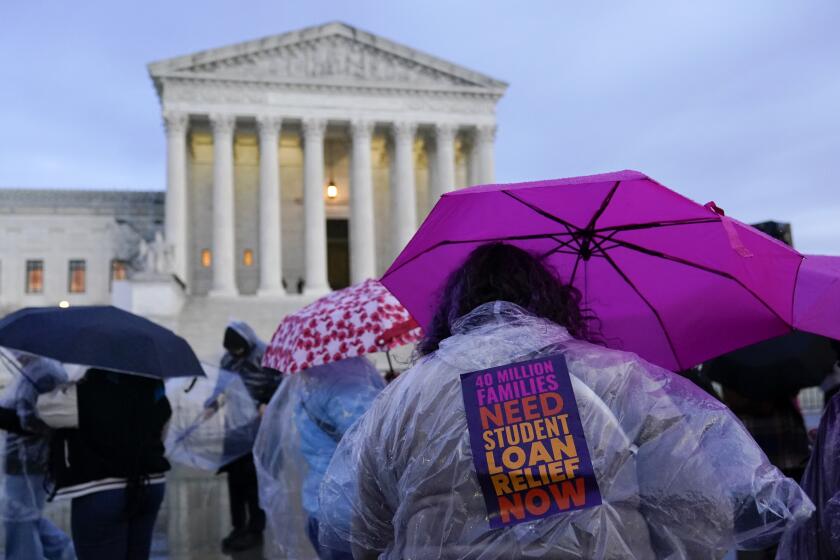Biden’s income-driven student loan repayment plan starts taking applications

- Share via
With payments on federal student loans scheduled to resume soon, the Biden administration launched a new repayment plan Tuesday that offers more affordable monthly payments to low- and moderate-income borrowers.
Dubbed the Saving on a Valuable Education plan, or SAVE, it’s a variation on the income-driven repayment plans that base monthly payments on what borrowers earn, not on how much they owe. Under these plans, any amount a borrower still owes after 20 to 25 years’ worth of payments will be forgiven.
In a standard repayment plan, by contrast, borrowers make higher monthly payments but erase their debt in 10 years.
The Education Department started taking applications for the SAVE plan on Tuesday at studentaid.gov/idr. The plan is available only to borrowers with loans made directly by the federal government.
The federal government suspended student loan payments and interest in early 2020 in light of the pandemic, but Congress put an end to the reprieve as part of a budget deal that lawmakers struck in June. Interest on federal student loans will begin accruing again in September and payments will be due in October, according to the Education Department.
The Supreme Court has ruled against the Biden administration’s blanket college loan forgiveness plan, denying debtors the instant relief the program offered. But they still have better options for managing their debt than they did before the court took up the case.
The SAVE plan will initially require borrowers to make monthly payments equal to 10% of their discretionary income — that is, 10% of the money they don’t need for housing, food and other necessities. That’s the same amount as in some other income-driven plans. But to make the payments more affordable, it will increase the amount of income considered non-discretionary by 50%.
In other income-driven plans, non-discretionary income is capped at 150% of the federal poverty level, which translates to $21,870 for a single individual or $45,000 for a family of four. With the SAVE plan, income up to 225% of the federal poverty level will be considered non-discretionary and excluded from the calculation of monthly payments.
The result, according to the administration, is that a single borrower who makes less than $32,800 a year would have a monthly payment of $0. The administration estimates that more than 1 million borrowers fall into that category.
One other immediate benefit: Borrowers on the SAVE plan whose monthly payments aren’t large enough to cover the interest their loan is accruing will not have that interest added to their loans. Under other income-driven repayment plans, borrowers who stay current can still see their debt grow as a consequence of unpaid interest.
On July 1, 2024, the SAVE plan will cut monthly payments on undergraduate student loans in half, to 5% of discretionary income. According to the department, borrowers with both undergraduate and graduate student loans would pay between 5% and 10% of their discretionary income, based on how much they borrowed for each level.
Once the plan goes into full effect, it will also offer speedier forgiveness for those who borrowed less. Ten years of repayments would be required for anyone who borrowed $12,000 or less; for each additional $1,000 borrowed, 12 more monthly payments would be required.
The Supreme Court has blocked Biden’s debt forgiveness plan, depriving his administration of a key tool to help borrowers begin repayment.
Parents who took out PLUS loans for their children don’t qualify for the SAVE plan. Borrowers who took out Perkins and Federal Family Education Loan program loans can enroll in SAVE if they consolidate their loans into a federal direct consolidated loan, but only if they don’t include any PLUS loans to parents in the package.
If you switch to the SAVE plan or another income-driven repayment plan, you will receive credit for the monthly payments you made under your previous plan. You’ll also be credited for the months when payments were suspended during the pandemic.
The Education Department says it will send borrowers a billing statement at least three weeks in advance, telling them when their payment is due and how much they owe. So if you haven’t done so already, you should confirm your contact information at the Federal Student Aid website, studentaid.gov.
You should also determine which company is servicing your federal loan or loans so you’ll know whom to pay. To find out, go to your account at studentaid.gov and select the “My Loan Servicers” list, or call the Federal Student Aid Information Center at (800) 433-3243.
Next, confirm how much you still owe and what the interest rates are on your loans. You can call your servicer to get its figures, or you can log in to your account at studentaid.gov and check the numbers there. Make sure the record shows all the payments you’ve made. If it doesn’t, call your servicer and point out which payments are missing. And if that doesn’t fix the problem, file a complaint with the Education Department.
About The Times Utility Journalism Team
This article is from The Times’ Utility Journalism Team. Our mission is to be essential to the lives of Southern Californians by publishing information that solves problems, answers questions and helps with decision making. We serve audiences in and around Los Angeles — including current Times subscribers and diverse communities that haven’t historically had their needs met by our coverage.
How can we be useful to you and your community? Email utility (at) latimes.com or one of our journalists: Jon Healey, Ada Tseng, Jessica Roy and Karen Garcia.
More to Read
Totally Worth It
Be your money's boss! Learn how to make a budget and take control of your finances with this eight-week newsletter course.
You may occasionally receive promotional content from the Los Angeles Times.












